Seasonal flows on warm Martian slopes

Seasonal flows on warm Martian slopes (also called recurring slope lineae, recurrent slope lineae and RSL)[1][2] are thought to be salty water flows occurring during the warmest months on Mars, or alternatively, dry grains that "flow" downslope of at least 27 degrees.
The flows are narrow (0.5 to 5 meters) and exhibit relatively dark markings on steep (25° to 40°) slopes, appear and incrementally grow during warm seasons and fade in cold seasons. Liquid brines near the surface have been proposed to explain this activity,[3] or dry granular flows.[4] On October 5, 2015, possible RSL were reported on Mount Sharp near the Curiosity rover.[2]
Overview
Research indicates that in the past there was liquid water flowing on the surface of Mars,[5][6][7] creating large areas similar to Earth's oceans.[8][9][10][11] However, the question remains as to where the water has gone.[12]
The Mars Reconnaissance Orbiter (MRO) is a multipurpose spacecraft launched in 2005 designed to conduct reconnaissance and exploration of Mars from orbit.[13] The spacecraft is managed by the Jet Propulsion Laboratory (JPL).[14] The HiRISE camera onboard the MRO is at the forefront of the ongoing RSL studies as it helps chart the features with images of closely monitored sites typically taken every few weeks.[15] The 2001 Mars Odyssey orbiter has been using spectrometers and a thermal imager for over 16 years to detect evidence of past or present water and ice.[4] [16] It has detected none at the RSL.[4]
Features
.gif)
Distinctive properties of recurring slope lineae (RSL) include slow incremental growth, formation on warm slopes in warm seasons, and annual fading and recurrence,[17] showing a strong correlation with solar heating.[17] RSL extend down slope from bedrock outcrops often following small gullies about 0.5 to 5 meters (1 ft 8 in to 16 ft 5 in) wide, with lengths up to hundreds of meters, and some of the locations display more than 1,000 individual flows.[18][19] RSL advance rates are highest at the beginning of each season, followed by much slower lengthening.[20] RSL appear and lengthen in the late southern spring and summer from 48°S to 32°S latitudes that favor equator-facing slopes, which are times and places with peak surface temperatures from −23 °C to 27 °C. Active RSL also occur in equatorial regions (0–15°S), most commonly in the Valles Marineris troughs.[20][21]
Researchers surveyed flow-marked slopes with the Mars Reconnaissance Orbiter's CRISM and although there is no spectrographic evidence for actual water,[18] the instrument has now directly imaged perchlorate salts thought to be dissolved in water brines in the subsurface.[3] This may indicate the water quickly evaporates upon reaching the surface, leaving only the salts. The cause of the surface darkening and lightening is poorly understood: a flow initiated by salty water (brine) could rearrange grains or change surface roughness in a way that darkens the appearance, but the way the features brighten again when temperatures drop is harder to explain.[14][22]
Hypotheses
A number of different hypotheses for RSL formation have been proposed. The seasonality, latitude distribution, and brightness changes strongly indicate a volatile material —such as water or liquid CO
2 — is involved. One hypothesis is that RSL could form by rapid heating of nocturnal frost.[17] Another one proposes flows of carbon dioxide, but the settings in which the flows occur are too warm for carbon-dioxide frost (CO
2), and at some sites is too cold for pure water.[17] Other hypotheses include dry granular flows, but no entirely dry process can explain seasonal flows that progressively grow over weeks and months.[20] Cornice avalanches is another hypothesis. The idea is that wind collects snow or frost just past the peak of a mountain and then this becomes an avalanche after it warms up. Seasonal melting of shallow ice would explain the RSL observations, but it would be difficult to replenish such ice annually.[20] However, as of 2015, direct observations of seasonal deposition of soluble salts strongly suggest that RSL involve brine (hydrated salts).[3]
Brines
The leading hypothesis involves the flow of brines —very salty water.[3][18][19][23][24][25] Salt deposits over much of Mars indicate that brine was abundant in Mars's past.[14][22] Salinity lowers the freezing point of water to sustain a liquid flow. Less saline water would freeze at the observed temperatures.[14] Thermal infrared data from the Thermal Emission Imaging System (THEMIS) on board the 2001 Mars Odyssey orbiter, have allowed the temperature conditions under which RSL form to be constrained. While a small number of RSL are visible at temperatures above the freezing point of water, most are not, and many appear at temperatures as low as −43 °C (230 K). Some scientists think that under these cold conditions, a brine of iron(III) sulphate (Fe2(SO4)3) or calcium chloride (CaCl
2) is the most likely mode of RSL formation.[26] Another team of scientists, using the CRISM instrument onboard MRO, reported that the evidence for hydrated salts is most consistent with the spectral absorption features of magnesium perchlorate (Mg(ClO4)2), magnesium chloride (MgCl2(H2O)x) and sodium perchlorate (NaClO
4).[3][25]
Experiments and calculations demonstrated that recurring slope lineae could be produced by the deliquescence and rehydration of hydrous chlorides and oxychlorine salts. However, under present Martian atmospheric conditions there is not enough water to complete this process.[27]
These observations are the closest scientists have come to finding evidence of liquid water on the planet's surface today.[14][22] Frozen water, however, has been detected near the surface in many middle to high-latitude regions. Purported droplets of brine also appeared on struts of the Phoenix Mars Lander in 2008.[28]
Source of water
Liquid brine flows near the surface might explain this activity, but the exact source of the water and the mechanism behind its motion are not understood.[29][30] A hypothesis proposes that the needed water could originate in the seasonal oscillations of near-surface adsorbed water provided by the atmosphere; perchlorates and other salts known to be present on the surface, are able to attract and hold water molecules from the surrounding environment (hygroscopic salts),[20] but the dryness of the Martian air is a challenge. Water vapor must be efficiently trapped over very small areas, and seasonal variation in the atmospheric column abundance of water vapor does not match the RSL activity over active locations.[17][20]
Deeper groundwater may exist and could reach the surface at springs or seeps,[31][32] but this cannot explain the wide distribution of RSL, extending from the tops of ridges and peaks.[20] Also, there are apparent RSL on equatorial dunes composed of permeable sand, unlikely to be a groundwater source.[20]
An analysis of data from the Mars Odyssey Neutron Spectrometer revealed that the RSL sites do not contain any more water than found at anywhere else at similar latitudes. The authors concluded that RSL are not supplied by large, near-surface briny aquifers. It is still possible with this data that water vapor from deeply buried ice, from the atmosphere, or from small deeply buried aquifers.[4]
Dry sand flows
Dry granular flow was proposed since the first observations of RSLs but this interpretation was ruled out because of the seasonality of the process. The first proposition of a seasonal triggering in a dry context was published in March 2017 using a Knudsen pump effect.[33] The authors demonstrated that the RSLs stopped at an angle of 28° in Garni crater, in agreement with dry granular avalanche. In addition, the authors pointed out several limitations of the wet hypothesis, such the fact that the detection of water was only indirect (salt detection but not water). This theory pushed back the dry flow theory. Research published in November 2017 concludes that the observations are best explained by dry flow processes,[34][35][36] and remark that there is no actual spectrographic evidence for water.[35][18] Their research shows RSL exist only on slopes steeper than 27 degrees, enough for dry grains to descend the way they do on faces of active dunes.[34] The RSL do not flow onto shallower than 27 degree slopes, which is inconsistent with models for water.[35] A 2016 report also cast doubt on possible sources of underground water at RSL sites,[37] but the new research article acknowledged that hydrated salts could draw some humidity from the atmosphere and seasonal changes in hydration of salt-containing grains might result in some trigger mechanism for RSL grainflows, such as expansion, contraction, or release of some water, that would change the cohesion of grains and cause them to fall or "flow" downslope.[34] Furthermore, neutron spectrometer data by the Mars Odyssey orbiter obtained over one decade, was published in December 2017, and shows no evidence of water (hydrogenated regolith) at the active sites, so its authors also support the hypotheses of either short-lived atmospheric water vapour deliquesence, or dry granular flows. Nevertheless, the footprint of this instrument (~100 km) is much larger than the RSls (~100m).[4]
Habitability
These features form on Sun-facing slopes at times of the year when the local temperatures reach above the melting point for ice. The streaks grow in spring, widen in late summer and then fade away in autumn. This is hard to model in any other way except as involving liquid water in some form, though the streaks themselves are thought to be a secondary effect and not a direct indication of dampness of the regolith. Although these features involve water in some form, the water could be either too cold or too salty for life. At present they are treated as potentially habitable, as "Uncertain Regions, to be treated as Special Regions".
The "Special Regions" assessment says of them:[38]
- "Although no single model currently proposed for the origin of RSL adequately explains all observations, they are currently best interpreted as being due to the seepage of water at >250 K (−23 °C; −10 °F), with [water activity] unknown and perhaps variable. As such they meet the criteria for Uncertain Regions, to be treated as Special Regions. There are other features on Mars with characteristics similar to RSL, but their relationship to water is much less likely."
Here a "Special Region" is defined as a region on the Mars surface where Earth life could potentially survive.
They were first reported on 5 August 2011.[39] They were already suspected as involving flowing brines back then, as all the other models involved water in some form. They were finally proven to involve water after detection of hydrated salts (brine) that change their hydration state rapidly through the season. This was reported on 28 September 2015.[40][41][42][43][44] The brines were not detected directly, because the resolution of the spectrometer is not high enough for this, and also the brines probably flow in the morning. The spacecraft that observed them, the Mars Reconnaissance Orbiter, is in a slowly precessing Sun-synchronous orbit inclined at 93 degrees (orbital period 1 hr 52 minutes). Each time it crosses the Mars equator on the sunny side, South to North, the time is 3:00 pm, in the local solar time on the surface, all year round. This is the worst time of day to spot brines from orbit.[45]
At the end of the press conference, the researchers gave a rough estimate of a total annual flow of at least 100,000 tons for the entire Valles Marineres region. In this calculation they assumed only 5% water in the solution and a film with a thickness of 10 mm which is about what is needed for the material to flow at all.[46] They are amongst the most favoured candidate sites to support Earth bacteria brought by contaminated landers.
Recurrent slope lineae near equator
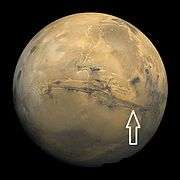 Image of disk of Mars taken by Viking. Arrow shows location of recurrent slope lineae in following HiRISE images.
Image of disk of Mars taken by Viking. Arrow shows location of recurrent slope lineae in following HiRISE images.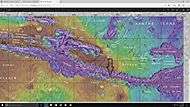 Labeled map of features near to Coprates Chasma. Arrow shows location of recurrent slope lineae in following HiRISE images.
Labeled map of features near to Coprates Chasma. Arrow shows location of recurrent slope lineae in following HiRISE images. Wide view of part of Valles Marineris, as seen by HiRISE under HiWish program Box shows location of recurrent slope lineae that are enlarged in next image.
Wide view of part of Valles Marineris, as seen by HiRISE under HiWish program Box shows location of recurrent slope lineae that are enlarged in next image.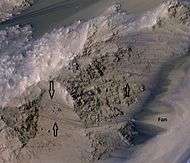 Close, color view of recurrent slope lineae, as seen by HiRISE under HiWish program Arrows point to some of the recurrent slope lineae. Fan may have been built up by past recurrent slope lineae.
Close, color view of recurrent slope lineae, as seen by HiRISE under HiWish program Arrows point to some of the recurrent slope lineae. Fan may have been built up by past recurrent slope lineae. Recurrent slope lineae elongate when the slopes are at their warmest. Near the equator, RSL elongate on northern slopes in the northern summer and on the southern slopes in the southern summer.
Recurrent slope lineae elongate when the slopes are at their warmest. Near the equator, RSL elongate on northern slopes in the northern summer and on the southern slopes in the southern summer.
Gallery
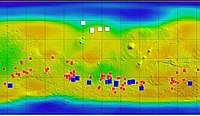 Ice (white), salt (red) and warm-season flows (blue) on Mars
Ice (white), salt (red) and warm-season flows (blue) on Mars.gif) Dark flows in Newton Crater extending during summer (video-gif).
Dark flows in Newton Crater extending during summer (video-gif)..gif) Warm season flows on slope in Horowitz Crater (video-gif).
Warm season flows on slope in Horowitz Crater (video-gif).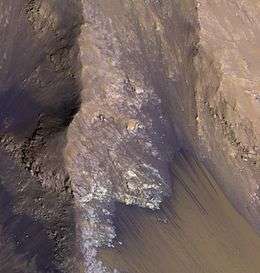 Seasonal flows on Coprates Chasma in Valles Marineris.
Seasonal flows on Coprates Chasma in Valles Marineris.
See also
References
- ↑ Kirby, Runyon; Ojha, Lujendra (August 18, 2014). "Encyclopedia of Planetary Landforms". Encyclopedia of Planetary Landforms. p. 1. doi:10.1007/978-1-4614-9213-9_352-1. ISBN 978-1-4614-9213-9. Retrieved September 26, 2015.
|chapter=ignored (help) - 1 2 Chang, Kenneth (5 October 2015). "Mars Is Pretty Clean. Her Job at NASA Is to Keep It That Way". New York Times. Retrieved 6 October 2015.
- 1 2 3 4 5 Ojha, Lujendra; Wilhelm, Mary Beth; Murchie, Scott L.; McEwen, Alfred S.; et al. (28 September 2015). "Spectral evidence for hydrated salts in recurring slope lineae on Mars". Nature Geoscience. 8 (11): 829. Bibcode:2015NatGe...8..829O. doi:10.1038/ngeo2546. Retrieved 2015-09-28.
- 1 2 3 4 5 Equatorial locations of water on Mars: Improved resolution maps based on Mars Odyssey Neutron Spectrometer data (PDF). Jack T. Wilson, Vincent R. Eke, Richard J. Massey, Richard C. Elphic, William C. Feldman, Sylvestre Maurice, Luıs F. A. Teodoroe. Icarus, 299, 148-160. January 2018. Quote: "Finally, we find that the sites of recurring slope lineae (RSL) do not correlate with subsurface hydration. This implies that RSL are not fed by large, near-subsurface aquifers, but are instead the result of either small (<120 km diameter) aquifers, deliquescence of perchlorate and chlorate salts or dry, granular flows."
- ↑ "Flashback: Water on Mars Announced 10 Years Ago". SPACE.com. June 22, 2000. Retrieved December 19, 2010.
- ↑ "Flashback: Water on Mars Announced 10 Years Ago". SPACE.com. June 22, 2010. Retrieved May 13, 2018.
- ↑ "Science@NASA, The Case of the Missing Mars Water". Archived from the original on March 27, 2009. Retrieved March 7, 2009.
- ↑ ISBN 0-312-24551-3
- ↑ "PSRD: Ancient Floodwaters and Seas on Mars". Psrd.hawaii.edu. July 16, 2003. Retrieved December 19, 2010.
- ↑ "Gamma-Ray Evidence Suggests Ancient Mars Had Oceans | SpaceRef". SpaceRef. November 17, 2008. Retrieved December 19, 2010.
- ↑ Carr, M.; Head, J. (2003). "Oceans on Mars: An assessment of the observational evidence and possible fate". Journal of Geophysical Research. 108: 5042. Bibcode:2003JGRE..108.5042C. doi:10.1029/2002JE001963.
- ↑ "Water on Mars: Where is it All?". Archived from the original on December 3, 2007. Retrieved March 7, 2009.
- ↑ "Nasa Find Potential Signs Of Flowing Water On Mars". Huffpost UK. August 4, 2011. Retrieved August 5, 2011.
- 1 2 3 4 5 "NASA Spacecraft Data Suggest Water Flowing on Mars". Jet Propulsion Laboratory, Pasadena, California. Retrieved March 31, 2012.
- ↑ David, Leonard (23 September 2015). "Mars' Mysterious Dark Streaks Spur Exploration Debate". Space.com. Retrieved 2015-09-25.
- ↑ "Mars Odyssey Goals". NASA JPL.
- 1 2 3 4 5 Dundas, C. M.; McEwen, A. S. (March 16–20, 2015). NEW CONSTRAINTS ON THE LOCATIONS, TIMING AND CONDITIONS FOR RECURRING SLOPE (PDF). 46th Lunar and Planetary Science Conference (2015). Lunar and Planetary Institute.
- 1 2 3 4 Mann, Adam (February 18, 2014). "Strange Dark Streaks on Mars Get More and More Mysterious". Wired. Retrieved February 18, 2014.
- 1 2 "Is Mars Weeping Salty Tears?". news.sciencemag.org. Archived from the original on August 14, 2011. Retrieved August 5, 2011.
- 1 2 3 4 5 6 7 8 McEwen, A.; Chojnacki, M.; Dundas, C.; L. Ojha, L. (28 September 2015). Recurring Slope Lineae on Mars: Atmospheric Origin? (PDF). European Planetary Science Congress 2015. France: EPSC Abstracts.
- ↑ Stillman, D., et al. 2016. Characteristics of the Numerous and Widespread Recurring Slope Lineae (RSL) in Valles Marineris, Mars. Icarus: 285, 195-210.
- 1 2 3 "NASA Spacecraft Data Suggest Water Flowing on Mars". NASA. Retrieved July 5, 2011.
- ↑ "NASA Finds Possible Signs of Flowing Water on Mars". voanews.com. Retrieved August 5, 2011.
- ↑ Webster, Guy; Brown, Dwayne (December 10, 2013). "NASA Mars Spacecraft Reveals a More Dynamic Red Planet". NASA. Retrieved December 10, 2013.
- 1 2 Wall, Mike (28 September 2015). "Salty Water Flows on Mars Today, Boosting Odds for Life". Space.com. Retrieved 2015-09-28.
- ↑ Mitchell, J.; Christensen, P. (March 16–20, 2015). RECURRING SLOPE LINEAE AND THE PRESENCE OF CHLORIDES IN THE SOUTHERN HEMISPHERE OF MARS (PDF). 46th Lunar and Planetary Science Conference (2015). Lunar and Planetary Institute.
- ↑ Wang, A., et al. 2017. ATMOSPHERE - SURFACE H2O EXCHANGE TO SUSTAIN THE RECURRING SLOPE LINEAE (RSL) ON MARS. Lunar and Planetary Science XLVIII (2017). 2351.pdf.
- ↑ "Mars Lander gets lucky break as 'water drops' discovered clinging to craft's leg". Daily Mail UK. March 18, 2009. Retrieved August 6, 2011.
- ↑ McEwen, Alfred.S.; Ojha, Lujendra; Dundas, Colin M. (June 17, 2011). "Seasonal Flows on Warm Martian Slopes". Science. American Association for the Advancement of Science. 333 (6043): 740–743. Bibcode:2011Sci...333..740M. doi:10.1126/science.1204816. ISSN 0036-8075. PMID 21817049. Retrieved August 5, 2011.
- ↑ "Seasonal Flows on Warm Martian Slopes". hirise.lpl.arizona.edu. Retrieved August 5, 2011.
- ↑ Levy, Joseph. "Hydrological characteristics of recurrent slope lineae on Mars: Evidence for liquid flow through regolith and comparisons with Antarctic terrestrial analogs." Icarus 219.1 (2012): 1-4.
- ↑ Martín-Torres, F. Javier; Zorzano, María-Paz; Valentín-Serrano, Patricia; Harri, Ari-Matti; Genzer, Maria (13 April 2015). "Transient liquid water and water activity at Gale crater on Mars". Nature Geoscience. 8 (5): 357. Bibcode:2015NatGe...8..357M. doi:10.1038/ngeo2412. Retrieved 2015-04-14.
- ↑ Formation of recurring slope lineae on Mars by rarefied gas-triggered granular flows. F. Schmidt, F. Andrieu, F. Costard, M. Kocifaj and A. G. Meresescu, Nature Geoscience, 20 March 2017. doi:10.1038/ngeo2917
- 1 2 3 Recurring Martian Streaks: Flowing Sand, Not Water?. JPL News, NASA. 20 November 2017.
- 1 2 3 Granular flows at recurring slope lineae on Mars indicate a limited role for liquid water. Colin M. Dundas, Alfred S. McEwen, Matthew Chojnacki, Moses P. Milazzo, Shane Byrne, Jim N. McElwaine, and Anna Urso. Nature Geoscience, 20 November 2017. doi:10.1038/s41561-017-0012-5
- ↑ A Mars Mystery: How Did Land Form Without Much Water?. Jan Raack. Space.com. 21 November 2017.
- ↑ Mars Canyons Study Adds Clues about Possible Water. JPL News, NASA. 7 July 2016.
- ↑ Rummel, John D.; Beaty, David W.; Jones, Melissa A.; Bakermans, Corien; Barlow, Nadine G.; Boston, Penelope J.; Chevrier, Vincent F.; Clark, Benton C.; de Vera, Jean-Pierre P.; Gough, Raina V.; Hallsworth, John E.; Head, James W.; Hipkin, Victoria J.; Kieft, Thomas L.; McEwen, Alfred S.; Mellon, Michael T.; Mikucki, Jill A.; Nicholson, Wayne L.; Omelon, Christopher R.; Peterson, Ronald; Roden, Eric E.; Sherwood Lollar, Barbara; Tanaka, Kenneth L.; Viola, Donna; Wray, James J. (2014). "A New Analysis of liquid "Special Regions": Findings of the Second MEPAG Special Regions Science Analysis Group (SR-SAG2)" (PDF). Astrobiology. 14 (11): 887–968. Bibcode:2014AsBio..14..887R. doi:10.1089/ast.2014.1227. ISSN 1531-1074. PMID 25401393.
- ↑ "Warm-Season Flows on Slope in Newton Crater". NASA Press Release.
- ↑ Martian salt streaks 'painted by liquid water' - BBC News
- ↑ Amos, Jonathan. "Martian salt streaks 'painted by liquid water'". BBC Science.
- ↑ Staff (28 September 2015). "Video Highlight - NASA News Conference - Evidence of Liquid Water on Today's Mars". NASA. Retrieved 30 September 2015.
- ↑ Staff (28 September 2015). "Video Complete - NASA News Conference - Water Flowing on Present-Day Mars m". NASA. Retrieved 30 September 2015.
- ↑ Ojha, L.; Wilhelm, M. B.; Murchie, S. L.; McEwen, A. S.; Wray, J. J.; Hanley, J.; Massé, M.; Chojnacki, M. (2015). "Spectral evidence for hydrated salts in recurring slope lineae on Mars". Nature Geoscience. 8 (11): 829–832. Bibcode:2015NatGe...8..829O. doi:10.1038/ngeo2546.
- ↑ "Mars Reconnaissance Orbiter Telecommunications" (PDF). JPL. September 2006.
- ↑ press conference on the discovery of indirect evidence of water flowing in the RSL - the video link here is to the question and answer about the quantity of water involved
External links
- NASA Picture Gallery on Seasonal flows on warm Martian slopes.